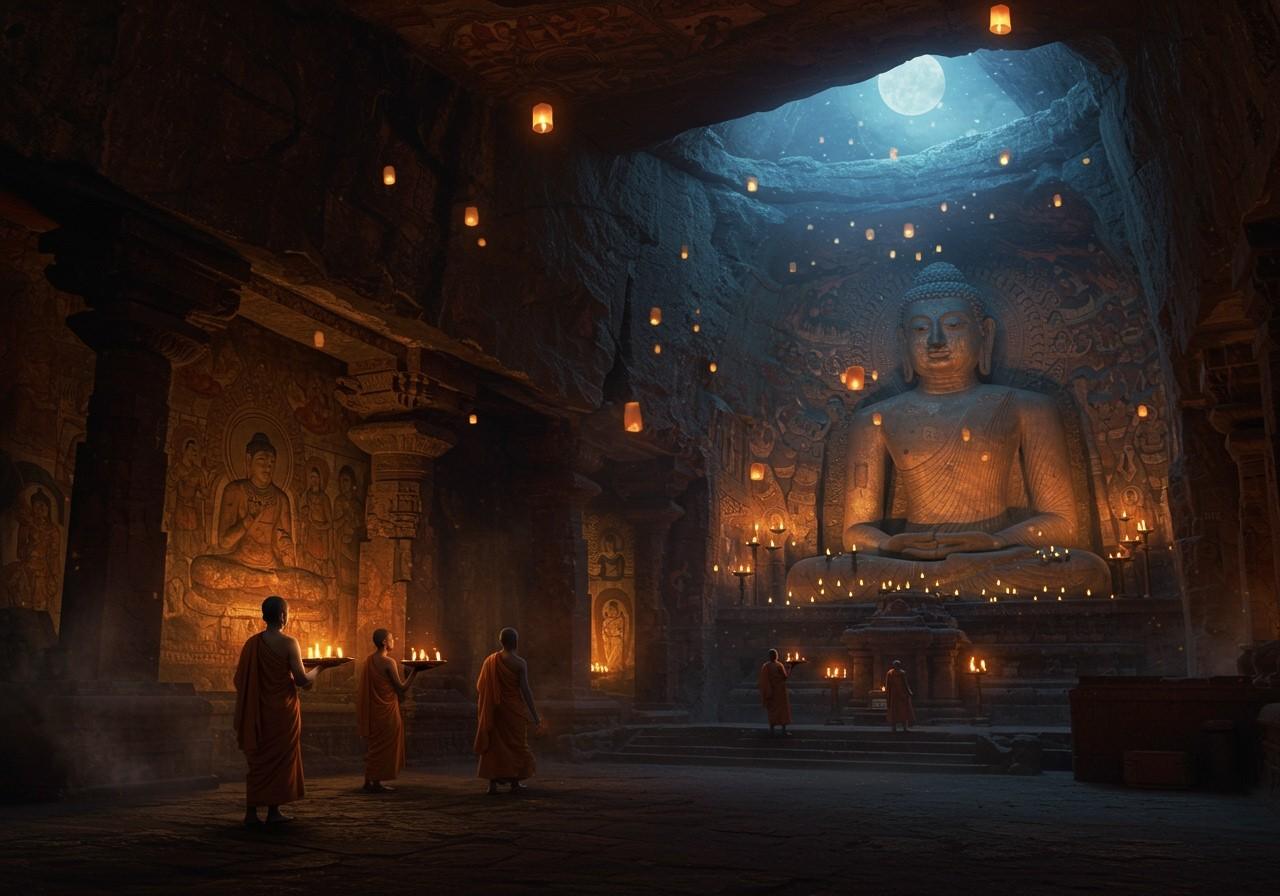
The Ajanta Caves, nestled in the Aurangabad district of Maharashtra, India, are a breathtaking collection of 30 rock-cut Buddhist cave monuments. Dating from the second century BCE to approximately 480 CE, these caves are celebrated globally as masterpieces of Buddhist religious art, showcasing intricate murals, rock-cut sculptures, and exemplary ancient Buddhist rock-cut architecture. They offer a unique window into the socio-cultural, religious, and political landscape of ancient India. Recognized as a UNESCO World Heritage Site, the Ajanta Caves continue to captivate visitors with their artistic traditions and historical significance.
Delving into the History of the Ajanta Caves
The development of the Ajanta Caves unfolded in two distinct phases. The initial phase commenced in the second century BCE under the Satavahana dynasty, while the second phase transpired during the 5th century CE under the Vakataka dynasty’s reign. These caves served as tranquil monastic sanctuaries for Buddhist monks, particularly during the monsoon season. Their secluded location within a steep ravine suggests their intended purpose for meditation and profound spiritual practices.
- Architectural Design: The caves’ architecture reflects the evolution of Buddhist thought, with early caves showcasing Hinayana (Theravada) influences and later caves exhibiting Mahayana characteristics. This architectural progression mirrors the development of Buddhist philosophy and practice over time.
- Monastic Retreats: Primarily utilized by monks for spiritual pursuits, the caves provided an environment conducive to contemplation, study, and the pursuit of enlightenment, fostering a vibrant monastic community.
Buddhist Art and Symbolism at Ajanta
The Ajanta Caves are renowned for their exquisite murals and sculptures, which vividly depict scenes from the life of Buddha, narratives from Jataka tales, and intricate depictions of Bodhisattvas. These artworks not only showcase the artistic prowess of the time but also serve as visual representations of Buddhist teachings and principles.
- Cave 1: This cave notably features depictions of Bodhisattva Padmapani and Vajrapani, embodying compassion and power, respectively. These figures highlight the importance of these qualities in Buddhist practice.
- Cave 26: A magnificent reclining Buddha statue graces Cave 26, symbolizing Mahaparinirvana (final nirvana). This powerful image represents the ultimate goal of Buddhist practice and the release from the cycle of rebirth.
These artistic treasures offer invaluable insights into the religious themes prevalent during that era and provide glimpses into contemporary socio-cultural aspects, including daily life, attire, and customs.
Religious Observances and Rituals
The Ajanta Caves served as vibrant centers of religious activity, where monks engaged in chanting, meditation, and various rituals. The architectural layout of the caves reflects these practices, with designated spaces for communal and individual spiritual pursuits.
- Stupas, Chaityas, Viharas: The presence of stupas, chaityas (prayer halls), and viharas (monasteries) within the cave complex points to both communal worship and individual spiritual practices, offering spaces for diverse forms of engagement with Buddhist teachings.
- Chaitya Halls (Cave 9 and Cave 10): Designed for congregational worship, these halls feature high ceilings and large open spaces, facilitating gatherings of monks and lay practitioners for shared religious observances.
- Viharas: Serving as living quarters for the monks, the viharas typically comprised simple cells arranged around a central hall, fostering a sense of community and providing spaces for communal activities.
The Dissemination of Buddhist Principles
The Ajanta Caves played a pivotal role in the propagation of Buddhism throughout India and beyond. Their distinct artistic and architectural styles influenced other prominent Buddhist sites, such as the Ellora Caves and Bagh Caves, contributing to the wider dissemination of Buddhist art and architecture.
- Visual Aids: The murals depicting Buddha and Bodhisattvas served as powerful visual aids in conveying the core principles of Buddhism to both monks and lay followers, facilitating understanding and promoting adherence to Buddhist teachings.
- Syncretic Nature: The art and architecture of the Ajanta Caves integrated elements from various regional styles and traditions, reflecting the syncretic nature of Buddhism and its ability to adapt and incorporate diverse cultural influences.
Poojn.in: Supporting Your Spiritual Journey
Planning a visit to the Ajanta Caves or seeking to deepen your understanding of their religious significance? Poojn.in offers a curated selection of items to enhance your spiritual journey. Explore our collection of authentic prayer beads (mala), incense sticks, Buddha statues, offering plates, prayer books, and meditation cushions, all crafted with reverence and attention to detail. Browse our collection of prayer beads, discover exquisite Buddha statues, and find other sacred items to support your practice.
Preservation and Modern Relevance
Rediscovered in 1819 by a British officer, the Ajanta Caves have garnered international acclaim. Designated as a UNESCO World Heritage Site, these caves are subject to ongoing conservation efforts to safeguard their delicate murals and sculptures from environmental factors.
- UNESCO World Heritage Site: The Ajanta Caves attract scholars, art historians, and tourists from across the globe, drawn to their exceptional artistic and historical significance.
- Conservation Efforts: Continuous conservation work aims to protect the fragile murals and sculptures from environmental damage, ensuring their preservation for future generations.
Conclusion
The Ajanta Caves stand as a testament to India’s rich cultural heritage and the enduring legacy of Buddhism. These ancient wonders offer a profound glimpse into the artistic brilliance and deep spiritual devotion of bygone eras. As we explore these magnificent caves, we gain a deeper appreciation for the traditions and values that have shaped our world. The ongoing preservation efforts ensure that future generations can continue to learn from and be inspired by this remarkable historical site.


